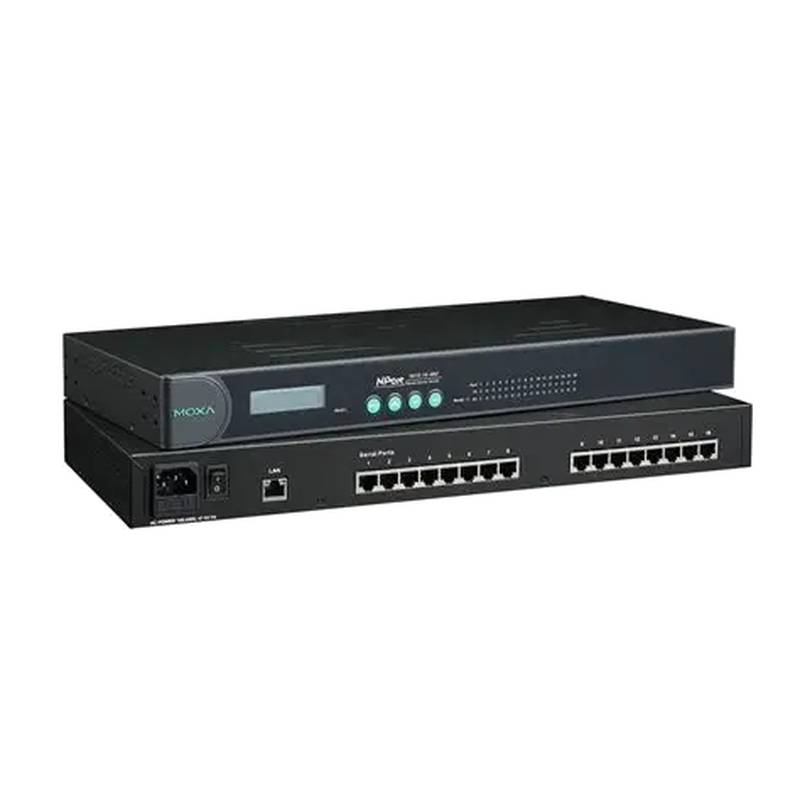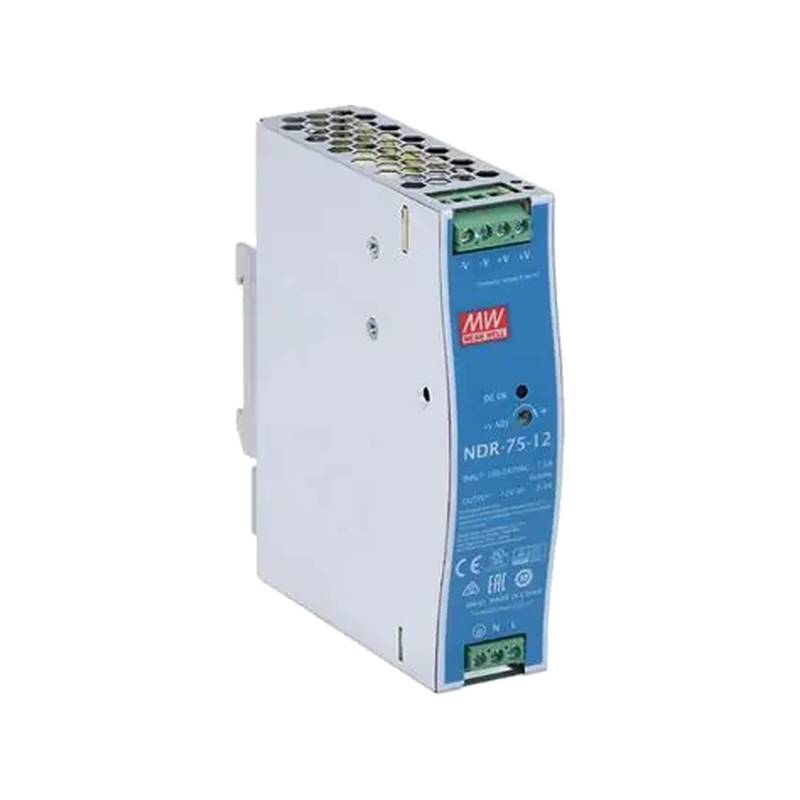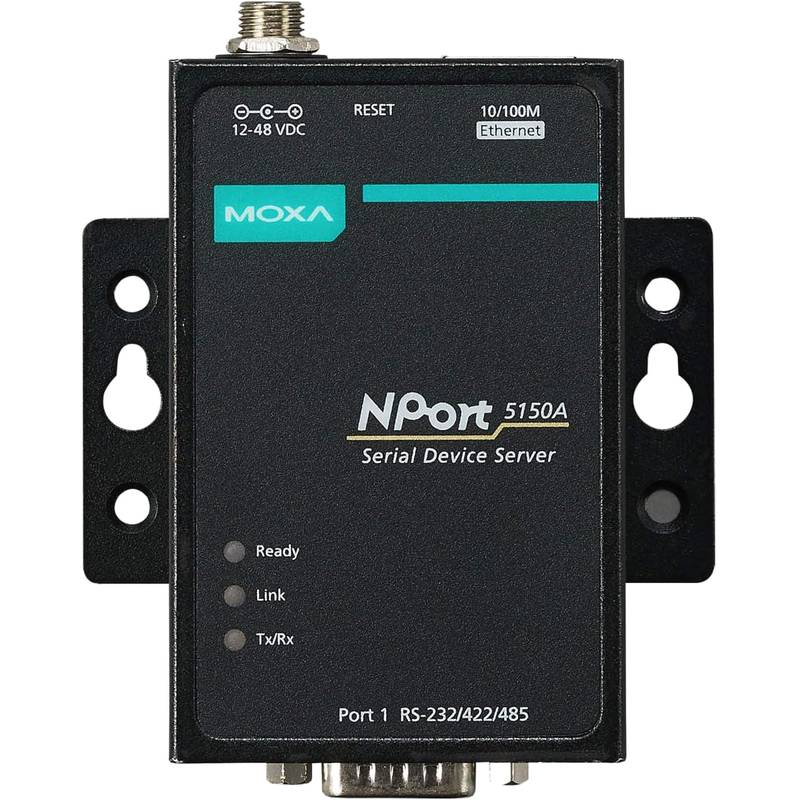
The Moxa NPort 5610-8 stands as a robust 8-port RS-232 serial device server, engineered for seamless industrial network integration and reliable serial-to-Ethernet connectivity. Its key advantages lie in its high port density, industrial-grade reliability, and versatile configuration options, making it an ideal solution for environments demanding stable and efficient data transmission. Core features include eight RS-232 serial ports, 10/100 Mbps Ethernet connectivity, and support for TCP/IP, UDP, and DHCP protocols, ensuring broad compatibility. Technical parameters of note are its compact form factor, wide operating temperature range of -20 to 70°C, and low power consumption.
Product Specifications
| Feature | Specification |
| :------------------- | :------------------------------------------------ |
| Serial Ports | 8 x RS-232 |
| Ethernet Interface | 1 x 10/100 Mbps Ethernet (RJ45) |
| Serial Signal | RS-232 (TxD, RxD, RTS, CTS, DTR, DSR, DCD, GND) |
| Baud Rate | 50 bps to 230.4 kbps |
| Data Bits | 5, 6, 7, 8 |
| Parity | None, Even, Odd, Space, Mark |
| Stop Bits | 1, 1.5, 2 |
| Flow Control | None, XON/XOFF, RTS/CTS |
| Protocol Support | TCP Server/Client, UDP Server/Client, Pair Mode |
| Management | Web Console, Telnet Console, Windows Utility |
| Power Input | 12-48 VDC |
| Operating Temperature | -20 to 70°C |
| Dimensions | 150 x 115 x 37 mm |
Core Features & Market Positioning
The Moxa NPort 5610-8 distinguishes itself in the competitive serial device server market through its superior port density, offering eight RS-232 interfaces within a single, space-saving unit. This high density reduces the need for multiple devices, simplifying infrastructure and lowering costs for applications requiring numerous serial connections. Its industrial-grade design ensures dependable operation in harsh environments, a critical factor for manufacturing, automation, and process control sectors. The device server's robust protocol support, including TCP Server/Client and UDP, alongside its versatile configuration tools, positions it as a flexible and powerful solution for legacy serial device integration into modern Ethernet networks. Reviews often highlight its stability and ease of deployment, cementing its reputation for reliability.
Key Application Scenarios
The Moxa NPort 5610-8 is exceptionally well-suited for scenarios demanding the modernization of legacy serial equipment. In industrial automation, it facilitates the connection of PLCs, SCADA systems, and sensor networks to Ethernet, enabling centralized monitoring and control. Manufacturing facilities leverage it to integrate assembly line machinery, barcode scanners, and testing equipment into their digital infrastructure. Furthermore, it finds application in building automation for managing HVAC systems, security devices, and access control panels, as well as in transportation for remote monitoring of signaling equipment and traffic management systems. Its ability to bridge serial and IP networks makes it indispensable for IoT initiatives and smart city deployments.
Practical System Integration Guidance
Integrating the Moxa NPort 5610-8 into an existing system is streamlined through its multiple management interfaces. Initial setup typically involves connecting the device to an Ethernet network and powering it on. Users can then access the NPort via its default IP address using Moxa's Windows utility or a web browser for comprehensive configuration. Serial port parameters, such as baud rate, data bits, parity, and stop bits, must be matched precisely to the connected serial devices. For connecting multiple serial devices, configuring the NPort's operational mode (e.g., TCP Server for multi-client connections or UDP for broadcast scenarios) is crucial. Wiring involves standard RS-232 DB9 connectors, ensuring correct pinouts for Tx, Rx, and handshake signals.
Operation and Risk Mitigation
Operating the Moxa NPort 5610-8 requires attention to network security and proper configuration to avoid common issues. It is advisable to change default login credentials and consider implementing network segmentation to isolate serial device traffic. Regularly updating the device's firmware to the latest stable version mitigates security vulnerabilities and can resolve potential bugs. Common troubleshooting steps include verifying physical connections, checking IP address conflicts, and ensuring serial port parameters are correctly set on both the NPort and the connected devices. For instance, if data is not transmitting, a mismatch in baud rate or flow control settings is a frequent culprit. The device's status LEDs provide valuable diagnostics for physical link and network activity.
Scalability & Long-Term Value
The Moxa NPort 5610-8 offers significant scalability and long-term value for organizations looking to modernize their industrial communication infrastructure. Its ability to support eight serial devices on a single Ethernet port reduces the need for extensive cabling and network hardware. As IIoT adoption grows, the NPort 5610-8 provides a proven and reliable bridge for integrating older serial equipment into broader digital transformation strategies, enabling data acquisition for analytics and remote management. Its compatibility with various industrial protocols and Moxa's commitment to ongoing firmware support ensure its relevance and functionality as networks evolve. The modular design and robust build quality contribute to its longevity in demanding operational environments.
Frequently Asked Questions
What are the primary advantages of using the Moxa NPort 5610-8?
The NPort 5610-8 offers high serial port density, reducing hardware needs and simplifying deployments.
It provides robust industrial-grade reliability for demanding operational environments.
Its versatile configuration options ensure seamless integration of legacy serial devices into modern networks.
How do I configure the serial port parameters on the NPort 5610-8?
Access the NPort via its IP address using a web browser or Moxa's utility.
Navigate to the serial port settings section within the configuration interface.
Precisely match the baud rate, data bits, parity, and stop bits to your connected serial device.
What network protocols does the Moxa NPort 5610-8 support?
It supports TCP Server and TCP Client modes for establishing network connections.
UDP Server and UDP Client modes are also available for datagram-based communication.
The device also includes Pair Mode for direct serial-to-serial communication over Ethernet.
Can I connect RS-422 or RS-485 devices to the NPort 5610-8?
No, the Moxa NPort 5610-8 is specifically designed for RS-232 serial communication only.
For RS-422 or RS-485 interfaces, you would need to select a different Moxa NPort model.
Always verify the serial interface type of your connected devices before purchasing.
What is the maximum baud rate supported by the NPort 5610-8?
The NPort 5610-8 supports serial communication speeds up to 230.4 kbps.
This high baud rate capability ensures efficient data transfer for most industrial applications.
Ensure your connected serial devices also support these higher communication speeds for optimal performance.
How does the NPort 5610-8 ensure reliable data transmission?
It employs industrial-grade components and a robust design for consistent performance.
Features like hardware watchdogs and configurable error handling enhance operational stability.
Proper network configuration and matching serial parameters are key to reliable data flow.
What are the power requirements for the Moxa NPort 5610-8?
The device operates on a DC power input range of 12 to 48 VDC.
This wide voltage range allows for flexible power sourcing in various industrial settings.
Ensure a stable and appropriate power supply is used for optimal device longevity.
How can I remotely manage the NPort 5610-8?
Remote management is possible via Telnet or a web browser over the Ethernet network.
Moxa's Windows-based utility also provides remote configuration and monitoring capabilities.
Secure access protocols and strong passwords are recommended for remote management.
What is the operating temperature range for this device server?
The Moxa NPort 5610-8 is designed to operate in a wide temperature range of -20 to 70°C.
This specification makes it suitable for deployment in many demanding industrial environments.
Ensure proper ventilation when operating at the higher end of the temperature range.
Does the NPort 5610-8 support IIoT integration?
Yes, it acts as a vital bridge for connecting legacy serial devices to IIoT platforms.
It enables data collection from older equipment for modern analytics and cloud-based management.
Its inclusion in an IIoT strategy facilitates digital transformation of existing infrastructure.























